Report on People Management: Leadership, Training & Talent at Nissan
VerifiedAdded on 2023/06/14
|8
|2159
|150
Report
AI Summary
This report provides an overview of people management practices at Nissan, a multinational automobile manufacturer. It focuses on three key areas: leadership and management, training and development, and talent management. The analysis of leadership and management explores Nissan's transformational leadership style and various management techniques used to foster teamwork and strategic planning. The section on training and development discusses innovative training methods, including the Targeted Leadership Training program and cross-functional teams. The report also examines talent management, emphasizing the importance of attracting, developing, and retaining talented staff members through strategic planning and employee satisfaction initiatives. The report concludes with recommendations for Nissan to enhance its people management strategies, such as incorporating microlearning and gamification into training programs and developing a comprehensive talent management mechanism.
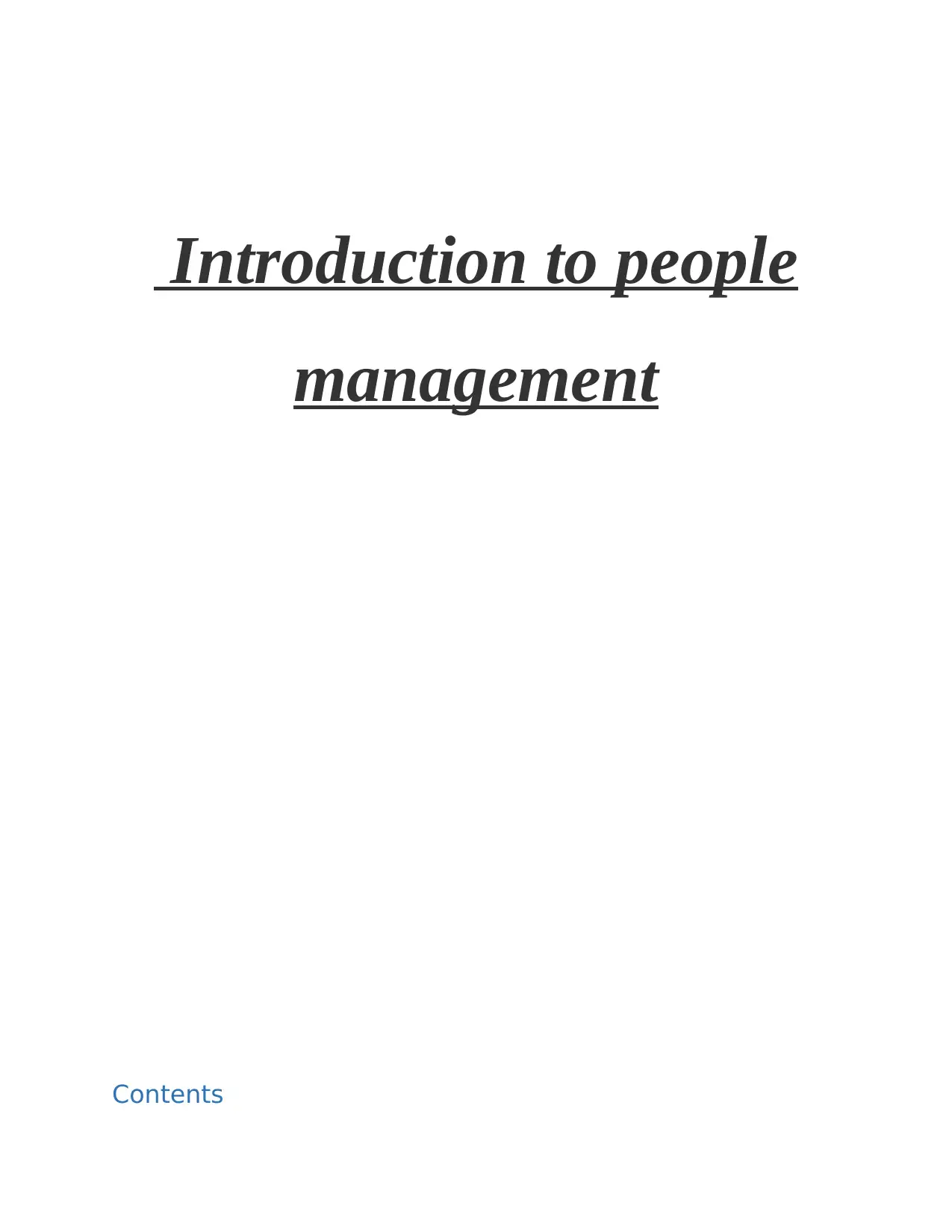
Introduction to people
management
Contents
management
Contents
Paraphrase This Document
Need a fresh take? Get an instant paraphrase of this document with our AI Paraphraser
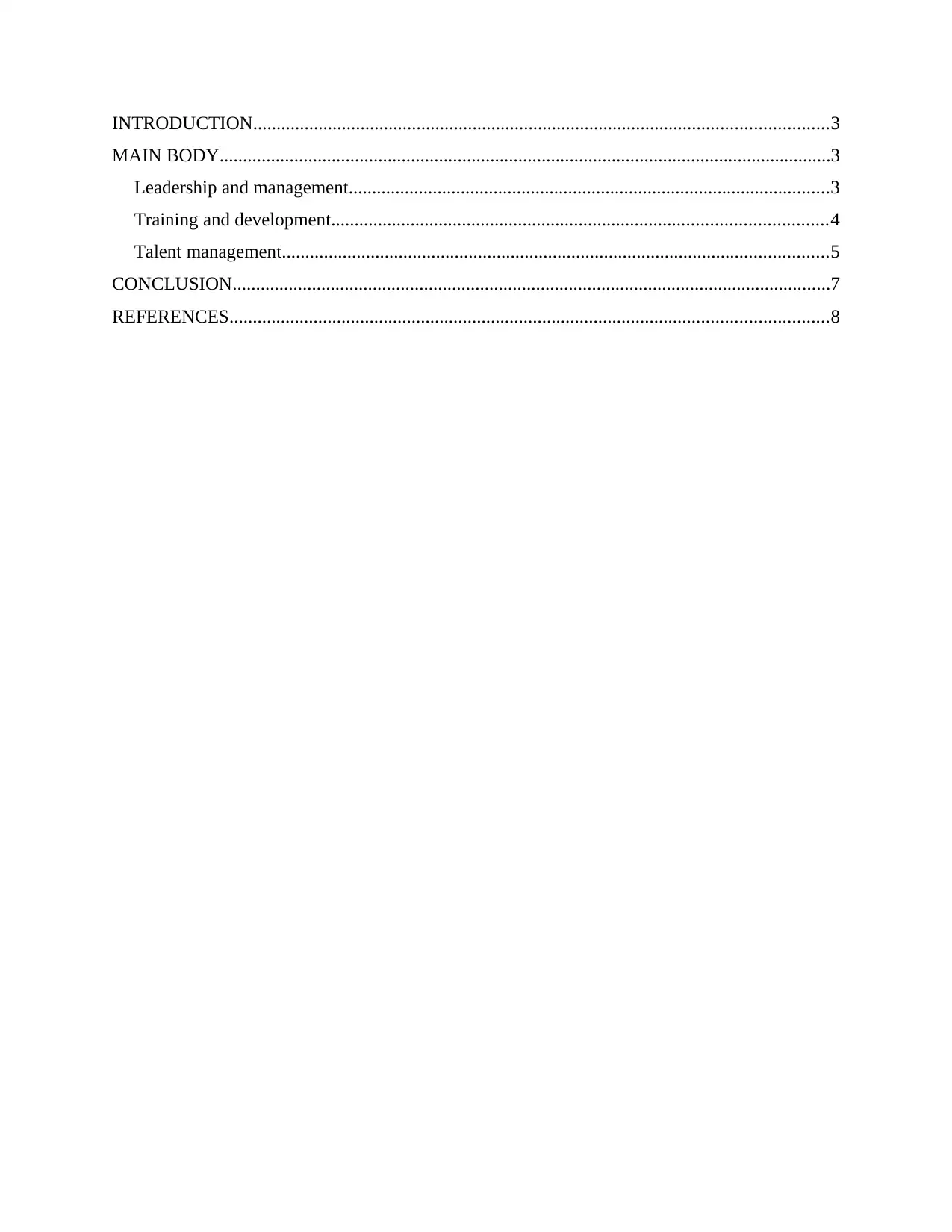
INTRODUCTION...........................................................................................................................3
MAIN BODY...................................................................................................................................3
Leadership and management.......................................................................................................3
Training and development..........................................................................................................4
Talent management.....................................................................................................................5
CONCLUSION................................................................................................................................7
REFERENCES................................................................................................................................8
MAIN BODY...................................................................................................................................3
Leadership and management.......................................................................................................3
Training and development..........................................................................................................4
Talent management.....................................................................................................................5
CONCLUSION................................................................................................................................7
REFERENCES................................................................................................................................8
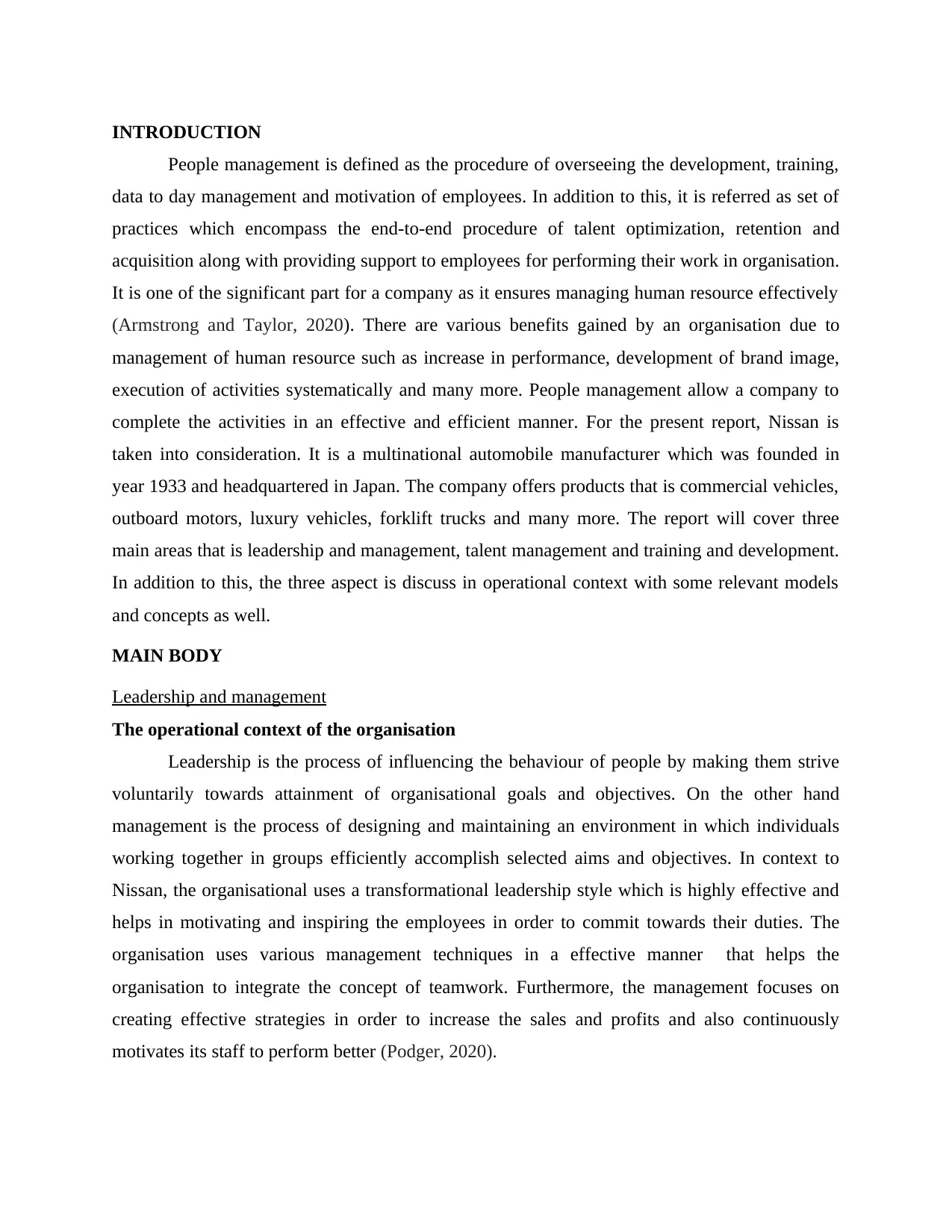
INTRODUCTION
People management is defined as the procedure of overseeing the development, training,
data to day management and motivation of employees. In addition to this, it is referred as set of
practices which encompass the end-to-end procedure of talent optimization, retention and
acquisition along with providing support to employees for performing their work in organisation.
It is one of the significant part for a company as it ensures managing human resource effectively
(Armstrong and Taylor, 2020). There are various benefits gained by an organisation due to
management of human resource such as increase in performance, development of brand image,
execution of activities systematically and many more. People management allow a company to
complete the activities in an effective and efficient manner. For the present report, Nissan is
taken into consideration. It is a multinational automobile manufacturer which was founded in
year 1933 and headquartered in Japan. The company offers products that is commercial vehicles,
outboard motors, luxury vehicles, forklift trucks and many more. The report will cover three
main areas that is leadership and management, talent management and training and development.
In addition to this, the three aspect is discuss in operational context with some relevant models
and concepts as well.
MAIN BODY
Leadership and management
The operational context of the organisation
Leadership is the process of influencing the behaviour of people by making them strive
voluntarily towards attainment of organisational goals and objectives. On the other hand
management is the process of designing and maintaining an environment in which individuals
working together in groups efficiently accomplish selected aims and objectives. In context to
Nissan, the organisational uses a transformational leadership style which is highly effective and
helps in motivating and inspiring the employees in order to commit towards their duties. The
organisation uses various management techniques in a effective manner that helps the
organisation to integrate the concept of teamwork. Furthermore, the management focuses on
creating effective strategies in order to increase the sales and profits and also continuously
motivates its staff to perform better (Podger, 2020).
People management is defined as the procedure of overseeing the development, training,
data to day management and motivation of employees. In addition to this, it is referred as set of
practices which encompass the end-to-end procedure of talent optimization, retention and
acquisition along with providing support to employees for performing their work in organisation.
It is one of the significant part for a company as it ensures managing human resource effectively
(Armstrong and Taylor, 2020). There are various benefits gained by an organisation due to
management of human resource such as increase in performance, development of brand image,
execution of activities systematically and many more. People management allow a company to
complete the activities in an effective and efficient manner. For the present report, Nissan is
taken into consideration. It is a multinational automobile manufacturer which was founded in
year 1933 and headquartered in Japan. The company offers products that is commercial vehicles,
outboard motors, luxury vehicles, forklift trucks and many more. The report will cover three
main areas that is leadership and management, talent management and training and development.
In addition to this, the three aspect is discuss in operational context with some relevant models
and concepts as well.
MAIN BODY
Leadership and management
The operational context of the organisation
Leadership is the process of influencing the behaviour of people by making them strive
voluntarily towards attainment of organisational goals and objectives. On the other hand
management is the process of designing and maintaining an environment in which individuals
working together in groups efficiently accomplish selected aims and objectives. In context to
Nissan, the organisational uses a transformational leadership style which is highly effective and
helps in motivating and inspiring the employees in order to commit towards their duties. The
organisation uses various management techniques in a effective manner that helps the
organisation to integrate the concept of teamwork. Furthermore, the management focuses on
creating effective strategies in order to increase the sales and profits and also continuously
motivates its staff to perform better (Podger, 2020).
⊘ This is a preview!⊘
Do you want full access?
Subscribe today to unlock all pages.

Trusted by 1+ million students worldwide
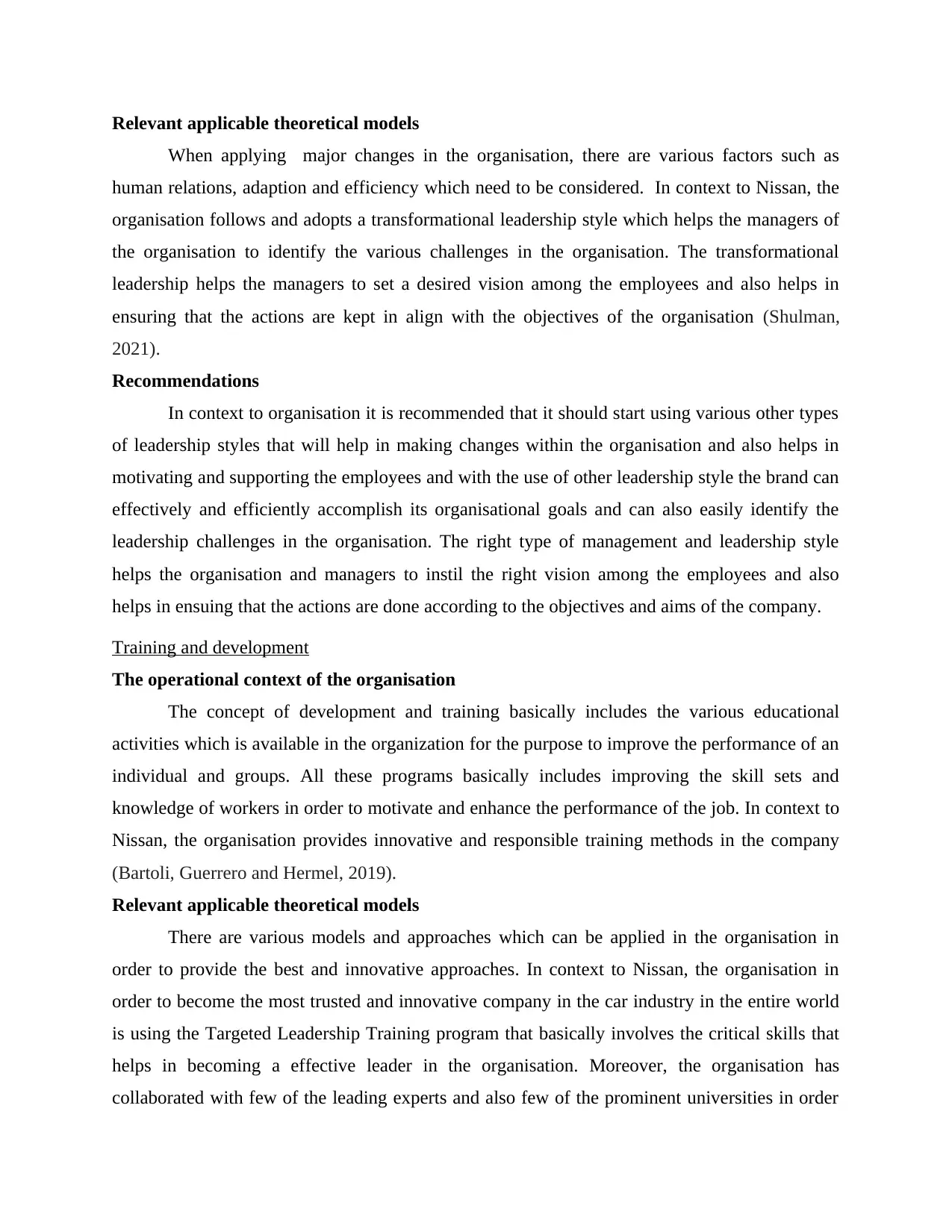
Relevant applicable theoretical models
When applying major changes in the organisation, there are various factors such as
human relations, adaption and efficiency which need to be considered. In context to Nissan, the
organisation follows and adopts a transformational leadership style which helps the managers of
the organisation to identify the various challenges in the organisation. The transformational
leadership helps the managers to set a desired vision among the employees and also helps in
ensuring that the actions are kept in align with the objectives of the organisation (Shulman,
2021).
Recommendations
In context to organisation it is recommended that it should start using various other types
of leadership styles that will help in making changes within the organisation and also helps in
motivating and supporting the employees and with the use of other leadership style the brand can
effectively and efficiently accomplish its organisational goals and can also easily identify the
leadership challenges in the organisation. The right type of management and leadership style
helps the organisation and managers to instil the right vision among the employees and also
helps in ensuing that the actions are done according to the objectives and aims of the company.
Training and development
The operational context of the organisation
The concept of development and training basically includes the various educational
activities which is available in the organization for the purpose to improve the performance of an
individual and groups. All these programs basically includes improving the skill sets and
knowledge of workers in order to motivate and enhance the performance of the job. In context to
Nissan, the organisation provides innovative and responsible training methods in the company
(Bartoli, Guerrero and Hermel, 2019).
Relevant applicable theoretical models
There are various models and approaches which can be applied in the organisation in
order to provide the best and innovative approaches. In context to Nissan, the organisation in
order to become the most trusted and innovative company in the car industry in the entire world
is using the Targeted Leadership Training program that basically involves the critical skills that
helps in becoming a effective leader in the organisation. Moreover, the organisation has
collaborated with few of the leading experts and also few of the prominent universities in order
When applying major changes in the organisation, there are various factors such as
human relations, adaption and efficiency which need to be considered. In context to Nissan, the
organisation follows and adopts a transformational leadership style which helps the managers of
the organisation to identify the various challenges in the organisation. The transformational
leadership helps the managers to set a desired vision among the employees and also helps in
ensuring that the actions are kept in align with the objectives of the organisation (Shulman,
2021).
Recommendations
In context to organisation it is recommended that it should start using various other types
of leadership styles that will help in making changes within the organisation and also helps in
motivating and supporting the employees and with the use of other leadership style the brand can
effectively and efficiently accomplish its organisational goals and can also easily identify the
leadership challenges in the organisation. The right type of management and leadership style
helps the organisation and managers to instil the right vision among the employees and also
helps in ensuing that the actions are done according to the objectives and aims of the company.
Training and development
The operational context of the organisation
The concept of development and training basically includes the various educational
activities which is available in the organization for the purpose to improve the performance of an
individual and groups. All these programs basically includes improving the skill sets and
knowledge of workers in order to motivate and enhance the performance of the job. In context to
Nissan, the organisation provides innovative and responsible training methods in the company
(Bartoli, Guerrero and Hermel, 2019).
Relevant applicable theoretical models
There are various models and approaches which can be applied in the organisation in
order to provide the best and innovative approaches. In context to Nissan, the organisation in
order to become the most trusted and innovative company in the car industry in the entire world
is using the Targeted Leadership Training program that basically involves the critical skills that
helps in becoming a effective leader in the organisation. Moreover, the organisation has
collaborated with few of the leading experts and also few of the prominent universities in order
Paraphrase This Document
Need a fresh take? Get an instant paraphrase of this document with our AI Paraphraser
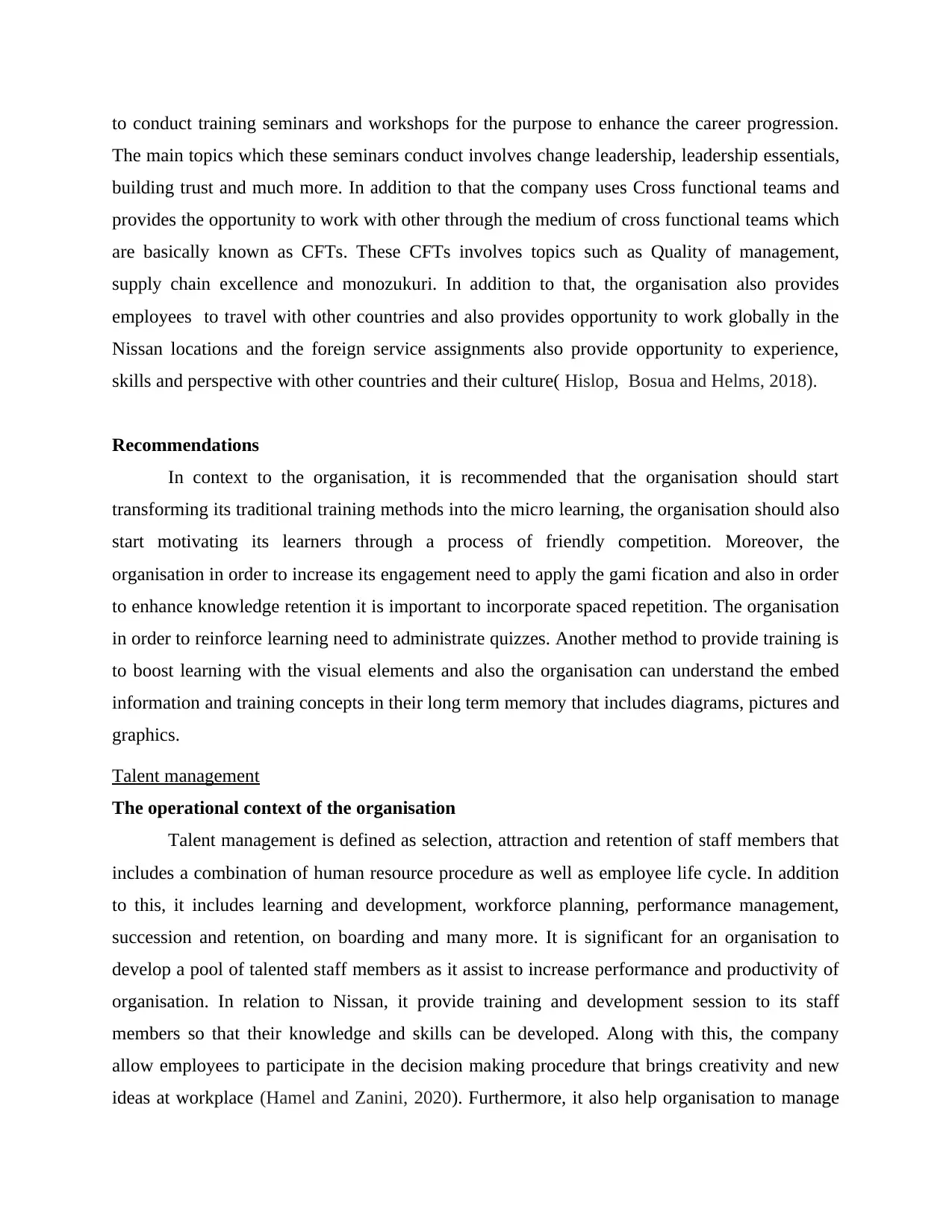
to conduct training seminars and workshops for the purpose to enhance the career progression.
The main topics which these seminars conduct involves change leadership, leadership essentials,
building trust and much more. In addition to that the company uses Cross functional teams and
provides the opportunity to work with other through the medium of cross functional teams which
are basically known as CFTs. These CFTs involves topics such as Quality of management,
supply chain excellence and monozukuri. In addition to that, the organisation also provides
employees to travel with other countries and also provides opportunity to work globally in the
Nissan locations and the foreign service assignments also provide opportunity to experience,
skills and perspective with other countries and their culture( Hislop, Bosua and Helms, 2018).
Recommendations
In context to the organisation, it is recommended that the organisation should start
transforming its traditional training methods into the micro learning, the organisation should also
start motivating its learners through a process of friendly competition. Moreover, the
organisation in order to increase its engagement need to apply the gami fication and also in order
to enhance knowledge retention it is important to incorporate spaced repetition. The organisation
in order to reinforce learning need to administrate quizzes. Another method to provide training is
to boost learning with the visual elements and also the organisation can understand the embed
information and training concepts in their long term memory that includes diagrams, pictures and
graphics.
Talent management
The operational context of the organisation
Talent management is defined as selection, attraction and retention of staff members that
includes a combination of human resource procedure as well as employee life cycle. In addition
to this, it includes learning and development, workforce planning, performance management,
succession and retention, on boarding and many more. It is significant for an organisation to
develop a pool of talented staff members as it assist to increase performance and productivity of
organisation. In relation to Nissan, it provide training and development session to its staff
members so that their knowledge and skills can be developed. Along with this, the company
allow employees to participate in the decision making procedure that brings creativity and new
ideas at workplace (Hamel and Zanini, 2020). Furthermore, it also help organisation to manage
The main topics which these seminars conduct involves change leadership, leadership essentials,
building trust and much more. In addition to that the company uses Cross functional teams and
provides the opportunity to work with other through the medium of cross functional teams which
are basically known as CFTs. These CFTs involves topics such as Quality of management,
supply chain excellence and monozukuri. In addition to that, the organisation also provides
employees to travel with other countries and also provides opportunity to work globally in the
Nissan locations and the foreign service assignments also provide opportunity to experience,
skills and perspective with other countries and their culture( Hislop, Bosua and Helms, 2018).
Recommendations
In context to the organisation, it is recommended that the organisation should start
transforming its traditional training methods into the micro learning, the organisation should also
start motivating its learners through a process of friendly competition. Moreover, the
organisation in order to increase its engagement need to apply the gami fication and also in order
to enhance knowledge retention it is important to incorporate spaced repetition. The organisation
in order to reinforce learning need to administrate quizzes. Another method to provide training is
to boost learning with the visual elements and also the organisation can understand the embed
information and training concepts in their long term memory that includes diagrams, pictures and
graphics.
Talent management
The operational context of the organisation
Talent management is defined as selection, attraction and retention of staff members that
includes a combination of human resource procedure as well as employee life cycle. In addition
to this, it includes learning and development, workforce planning, performance management,
succession and retention, on boarding and many more. It is significant for an organisation to
develop a pool of talented staff members as it assist to increase performance and productivity of
organisation. In relation to Nissan, it provide training and development session to its staff
members so that their knowledge and skills can be developed. Along with this, the company
allow employees to participate in the decision making procedure that brings creativity and new
ideas at workplace (Hamel and Zanini, 2020). Furthermore, it also help organisation to manage
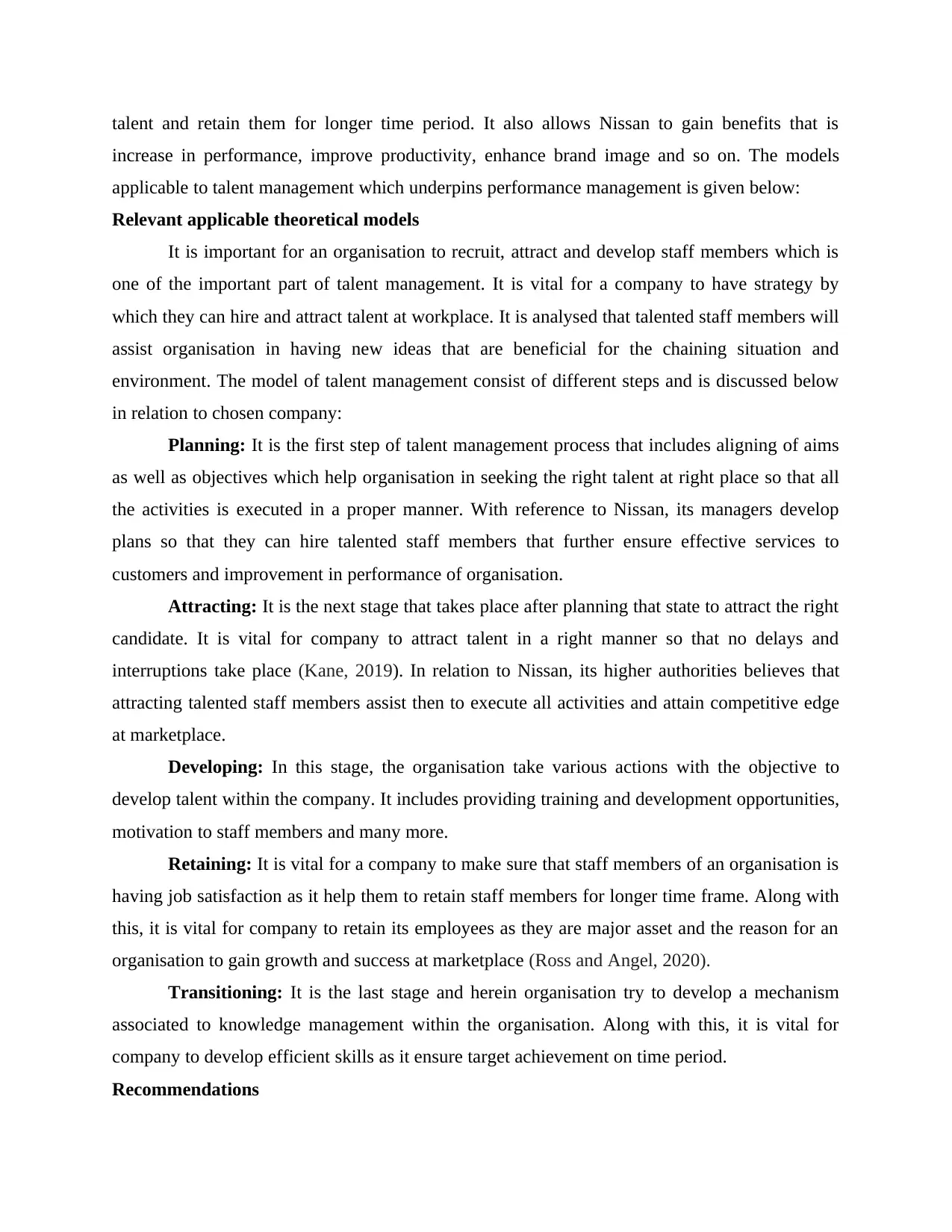
talent and retain them for longer time period. It also allows Nissan to gain benefits that is
increase in performance, improve productivity, enhance brand image and so on. The models
applicable to talent management which underpins performance management is given below:
Relevant applicable theoretical models
It is important for an organisation to recruit, attract and develop staff members which is
one of the important part of talent management. It is vital for a company to have strategy by
which they can hire and attract talent at workplace. It is analysed that talented staff members will
assist organisation in having new ideas that are beneficial for the chaining situation and
environment. The model of talent management consist of different steps and is discussed below
in relation to chosen company:
Planning: It is the first step of talent management process that includes aligning of aims
as well as objectives which help organisation in seeking the right talent at right place so that all
the activities is executed in a proper manner. With reference to Nissan, its managers develop
plans so that they can hire talented staff members that further ensure effective services to
customers and improvement in performance of organisation.
Attracting: It is the next stage that takes place after planning that state to attract the right
candidate. It is vital for company to attract talent in a right manner so that no delays and
interruptions take place (Kane, 2019). In relation to Nissan, its higher authorities believes that
attracting talented staff members assist then to execute all activities and attain competitive edge
at marketplace.
Developing: In this stage, the organisation take various actions with the objective to
develop talent within the company. It includes providing training and development opportunities,
motivation to staff members and many more.
Retaining: It is vital for a company to make sure that staff members of an organisation is
having job satisfaction as it help them to retain staff members for longer time frame. Along with
this, it is vital for company to retain its employees as they are major asset and the reason for an
organisation to gain growth and success at marketplace (Ross and Angel, 2020).
Transitioning: It is the last stage and herein organisation try to develop a mechanism
associated to knowledge management within the organisation. Along with this, it is vital for
company to develop efficient skills as it ensure target achievement on time period.
Recommendations
increase in performance, improve productivity, enhance brand image and so on. The models
applicable to talent management which underpins performance management is given below:
Relevant applicable theoretical models
It is important for an organisation to recruit, attract and develop staff members which is
one of the important part of talent management. It is vital for a company to have strategy by
which they can hire and attract talent at workplace. It is analysed that talented staff members will
assist organisation in having new ideas that are beneficial for the chaining situation and
environment. The model of talent management consist of different steps and is discussed below
in relation to chosen company:
Planning: It is the first step of talent management process that includes aligning of aims
as well as objectives which help organisation in seeking the right talent at right place so that all
the activities is executed in a proper manner. With reference to Nissan, its managers develop
plans so that they can hire talented staff members that further ensure effective services to
customers and improvement in performance of organisation.
Attracting: It is the next stage that takes place after planning that state to attract the right
candidate. It is vital for company to attract talent in a right manner so that no delays and
interruptions take place (Kane, 2019). In relation to Nissan, its higher authorities believes that
attracting talented staff members assist then to execute all activities and attain competitive edge
at marketplace.
Developing: In this stage, the organisation take various actions with the objective to
develop talent within the company. It includes providing training and development opportunities,
motivation to staff members and many more.
Retaining: It is vital for a company to make sure that staff members of an organisation is
having job satisfaction as it help them to retain staff members for longer time frame. Along with
this, it is vital for company to retain its employees as they are major asset and the reason for an
organisation to gain growth and success at marketplace (Ross and Angel, 2020).
Transitioning: It is the last stage and herein organisation try to develop a mechanism
associated to knowledge management within the organisation. Along with this, it is vital for
company to develop efficient skills as it ensure target achievement on time period.
Recommendations
⊘ This is a preview!⊘
Do you want full access?
Subscribe today to unlock all pages.

Trusted by 1+ million students worldwide
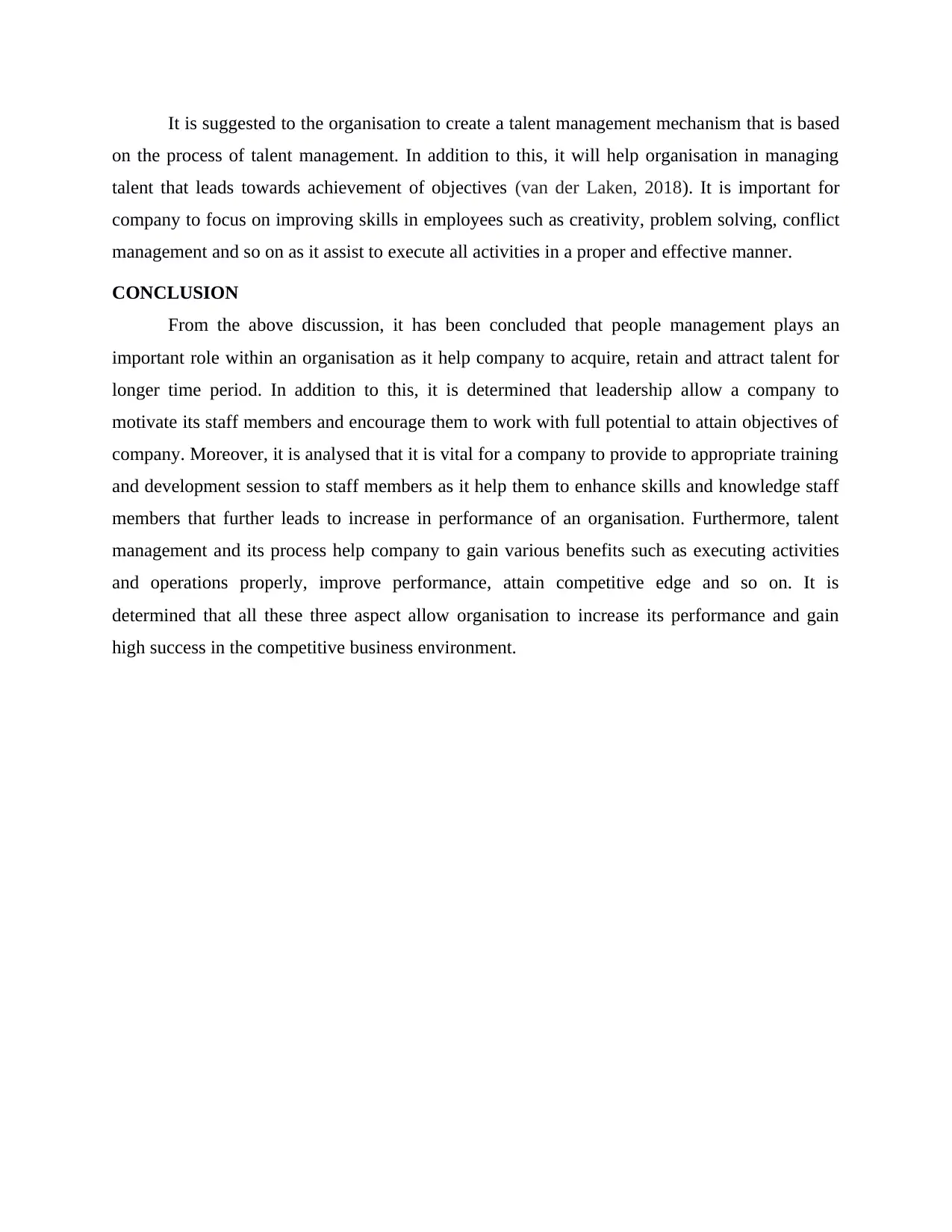
It is suggested to the organisation to create a talent management mechanism that is based
on the process of talent management. In addition to this, it will help organisation in managing
talent that leads towards achievement of objectives (van der Laken, 2018). It is important for
company to focus on improving skills in employees such as creativity, problem solving, conflict
management and so on as it assist to execute all activities in a proper and effective manner.
CONCLUSION
From the above discussion, it has been concluded that people management plays an
important role within an organisation as it help company to acquire, retain and attract talent for
longer time period. In addition to this, it is determined that leadership allow a company to
motivate its staff members and encourage them to work with full potential to attain objectives of
company. Moreover, it is analysed that it is vital for a company to provide to appropriate training
and development session to staff members as it help them to enhance skills and knowledge staff
members that further leads to increase in performance of an organisation. Furthermore, talent
management and its process help company to gain various benefits such as executing activities
and operations properly, improve performance, attain competitive edge and so on. It is
determined that all these three aspect allow organisation to increase its performance and gain
high success in the competitive business environment.
on the process of talent management. In addition to this, it will help organisation in managing
talent that leads towards achievement of objectives (van der Laken, 2018). It is important for
company to focus on improving skills in employees such as creativity, problem solving, conflict
management and so on as it assist to execute all activities in a proper and effective manner.
CONCLUSION
From the above discussion, it has been concluded that people management plays an
important role within an organisation as it help company to acquire, retain and attract talent for
longer time period. In addition to this, it is determined that leadership allow a company to
motivate its staff members and encourage them to work with full potential to attain objectives of
company. Moreover, it is analysed that it is vital for a company to provide to appropriate training
and development session to staff members as it help them to enhance skills and knowledge staff
members that further leads to increase in performance of an organisation. Furthermore, talent
management and its process help company to gain various benefits such as executing activities
and operations properly, improve performance, attain competitive edge and so on. It is
determined that all these three aspect allow organisation to increase its performance and gain
high success in the competitive business environment.
Paraphrase This Document
Need a fresh take? Get an instant paraphrase of this document with our AI Paraphraser
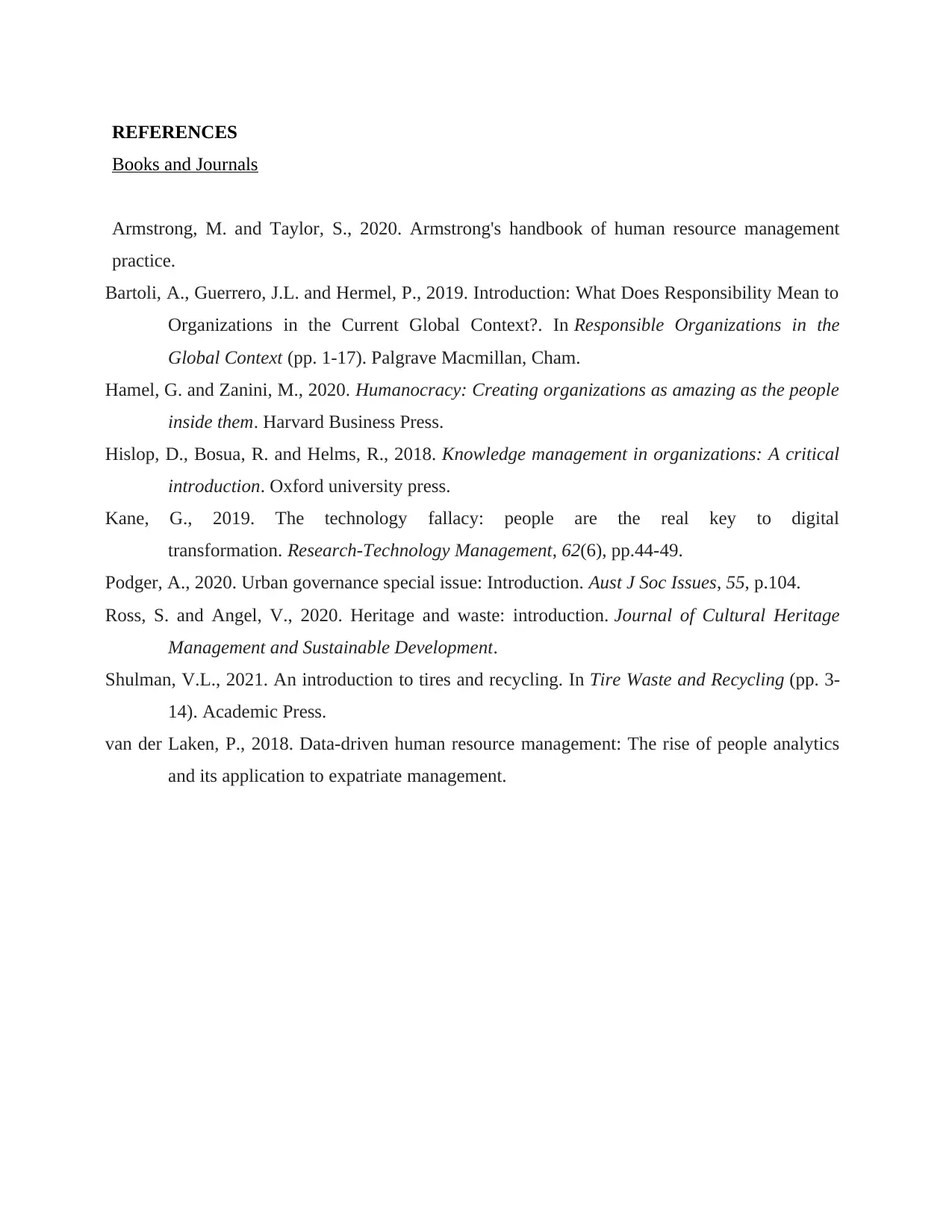
REFERENCES
Books and Journals
Armstrong, M. and Taylor, S., 2020. Armstrong's handbook of human resource management
practice.
Bartoli, A., Guerrero, J.L. and Hermel, P., 2019. Introduction: What Does Responsibility Mean to
Organizations in the Current Global Context?. In Responsible Organizations in the
Global Context (pp. 1-17). Palgrave Macmillan, Cham.
Hamel, G. and Zanini, M., 2020. Humanocracy: Creating organizations as amazing as the people
inside them. Harvard Business Press.
Hislop, D., Bosua, R. and Helms, R., 2018. Knowledge management in organizations: A critical
introduction. Oxford university press.
Kane, G., 2019. The technology fallacy: people are the real key to digital
transformation. Research-Technology Management, 62(6), pp.44-49.
Podger, A., 2020. Urban governance special issue: Introduction. Aust J Soc Issues, 55, p.104.
Ross, S. and Angel, V., 2020. Heritage and waste: introduction. Journal of Cultural Heritage
Management and Sustainable Development.
Shulman, V.L., 2021. An introduction to tires and recycling. In Tire Waste and Recycling (pp. 3-
14). Academic Press.
van der Laken, P., 2018. Data-driven human resource management: The rise of people analytics
and its application to expatriate management.
Books and Journals
Armstrong, M. and Taylor, S., 2020. Armstrong's handbook of human resource management
practice.
Bartoli, A., Guerrero, J.L. and Hermel, P., 2019. Introduction: What Does Responsibility Mean to
Organizations in the Current Global Context?. In Responsible Organizations in the
Global Context (pp. 1-17). Palgrave Macmillan, Cham.
Hamel, G. and Zanini, M., 2020. Humanocracy: Creating organizations as amazing as the people
inside them. Harvard Business Press.
Hislop, D., Bosua, R. and Helms, R., 2018. Knowledge management in organizations: A critical
introduction. Oxford university press.
Kane, G., 2019. The technology fallacy: people are the real key to digital
transformation. Research-Technology Management, 62(6), pp.44-49.
Podger, A., 2020. Urban governance special issue: Introduction. Aust J Soc Issues, 55, p.104.
Ross, S. and Angel, V., 2020. Heritage and waste: introduction. Journal of Cultural Heritage
Management and Sustainable Development.
Shulman, V.L., 2021. An introduction to tires and recycling. In Tire Waste and Recycling (pp. 3-
14). Academic Press.
van der Laken, P., 2018. Data-driven human resource management: The rise of people analytics
and its application to expatriate management.
1 out of 8
Related Documents
Your All-in-One AI-Powered Toolkit for Academic Success.
+13062052269
info@desklib.com
Available 24*7 on WhatsApp / Email
![[object Object]](/_next/static/media/star-bottom.7253800d.svg)
Unlock your academic potential
Copyright © 2020–2025 A2Z Services. All Rights Reserved. Developed and managed by ZUCOL.




